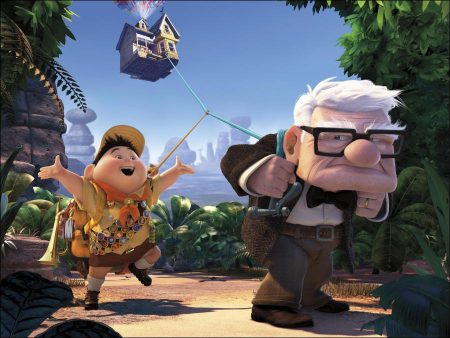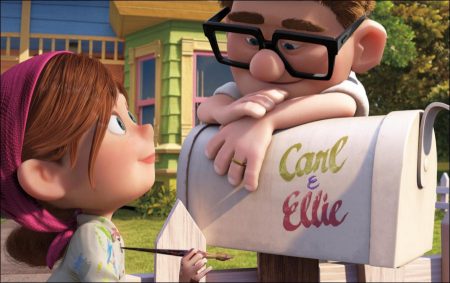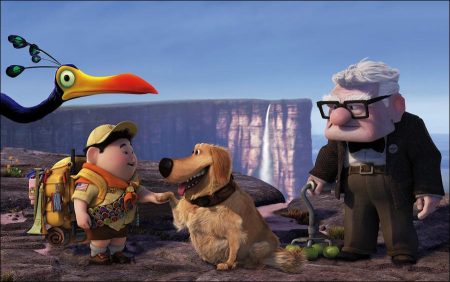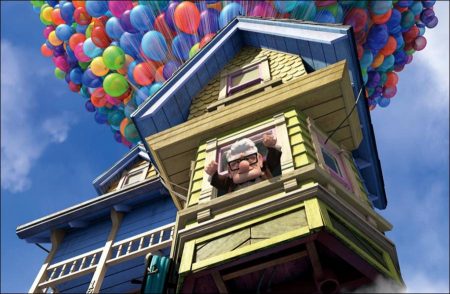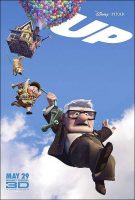Taglines: Fly Up to Venezuela.
78-year-old balloon salesman Carl Fredricksen finally fulfills his lifelong dream of a great adventure when he ties thousands of balloons to his house and flies away to the wilds of South America. But he discovers all too late that his biggest nightmare has stowed away on the trip: an overly optimistic 9-year-old Wilderness Explorer named Russell.
Walt Disney Pictures and Pixar Animation Studios take moviegoers up, up and away on one of the funniest adventures of all time with their latest comedy-fantasy “Up,” from Academy Award-nominated director Pete Docter (“Monsters, Inc.”). Presented in Disney Digital 3D™, “Up” follows the uplifting tale of 78-year-old balloon salesman Carl Fredricksen, who finally fulfills his lifelong dream of a great adventure when he ties thousands of balloons to his house and flies away to the wilds of South America. But he discovers all too late that his biggest nightmare has stowed away on the trip: an overly optimistic 8-year-old Wilderness Explorer named Russell. Their journey to a lost world, where they encounter some strange, exotic and surprising characters, is filled with hilarity, emotion and wildly imaginative adventure.
“I am so proud that `Up’ is Pixar’s 10th film,” says John Lasseter, executive producer and chief creative officer for Walt Disney and Pixar Animation Studios. “I think it’s the funniest film that we’ve ever made, and also one of the most beautiful. We have a main character that is an amazing hero. Carl Fredricksen is 78 years old and he travels the world in a flying machine of his own design and still has dinner at 3:30 in the afternoon. He’s the most unlikely hero you can imagine in an action picture. He is a character who learns that the big adventures in life are all the small things that happen in everyday life. Russell is one of the most appealing and charming characters that we’ve ever created. Together with Carl, these two characters light up the screen.”
The film is directed by Pixar veteran Pete Docter, who joined the studio in 1990-just the third animator to be brought on board. Along with Lasseter and Andrew Stanton, Docter developed the story and characters for “Toy Story,” Pixar’s first full-length feature film, for which he also served as supervising animator. He was a storyboard artist on “A Bug’s Life” and wrote the initial story treatment for “Toy Story 2.” Docter made his debut as a director on “Monsters, Inc.,” which received an Academy Award® nomination for Best Animated Feature Film. As one of Pixar Animation Studios’ key creative contributors, Docter garnered another Academy Award nomination for his original story credit on Disney•Pixar’s Oscar“-winning “WALL•E.”
About the Production
“For me personally, what makes a film worth watching is when you go home and you’re still thinking about it,” says Docter. “You leave the theater and you’re still thinking about it not only the next day, but the next year. In order to have a film affect you that way, it has to have real true emotion and resonate in some way with your own life. So even though the stars of the film may be monsters or bugs, you identify with those characters on the screen and you understand what they’re going through. It’s important to have that foundation of real truth and an emotional attachment to the characters.”
“Along with the humor, you have to have heart,” says Lasseter. “Walt Disney always said, `For every laugh, there should be a tear.’ I believe in that.” Filmmakers found a lot of heart in their latest adventure, exploring the love that Carl and his late wife shared and the friendship that develops between Carl and Russell. In fact, Carl discovers that life’s true adventure can be found not in travel or great accomplishments, but in the everyday relationships that we have with friends and family.”
“Up” is executive produced by Academy Award-winning filmmakers and Pixar pioneers Lasseter (director of “Toy Story,” “A Bug’s Life,” “Toy Story 2,” and “Cars”) and Stanton (director of “Finding Nemo,” “WALL•E”). Pixar veteran Jonas Rivera served as the film’s producer. The co-director is Bob Peterson, and the screenplay is by Peterson and Pete Docter from a story by Docter, Peterson, and Tom McCarthy (“The Station Agent,” “The Visitor”). Oscar-nominated composer Michael Giacchino (“Ratatouille,” “The Incredibles”) lends his musical talents to creating the evocative score that accentuates the emotions, humor and spirit of adventure.
The voice cast for “Up” features legendary actor Ed Asner, a multiple Emmy Award winner, as balloon salesman-turned-adventurer Carl Fredricksen. Nine-year-old Jordan Nagai makes his acting debut as the voice of the determined and eager-to-assist Junior Wilderness Explorer, Russell. Acclaimed Emmy Award-winning actor Christopher Plummer gives a rich and textured vocal performance as the voice of Charles Muntz, a faded hero with an obsession to restore his good name. John Ratzenberger, Pixar’s “lucky charm”-the only actor to lend his voice to all of the Studio’s feature films, provides the voice of a construction foreman named Tom, who tries to encourage Carl to sell his home. Muntz’s dog pack includes vocal performances by Bob Peterson, Delroy Lindo and Jerome Ranft.
“Up” is the 10th film from Disney•Pixar, which has gone nine for nine with an unprecedented streak of hugely successful films, including “WALL•E,” “Ratatouille,” “Cars,” “The Incredibles,” “Finding Nemo,” “Monsters, Inc.,” “Toy Story 2,” “A Bug’s Life” and “Toy Story.” Pixar now has nine of the 25 top-grossing animated films of all time domestically, and all nine have been #1 at the box office on their opening weekends of wide release.
“WALL•E,” “Ratatouille,” “The Incredibles” and “Finding Nemo” all earned Academy Awards® for Best Animated Feature, an award that was introduced in 2001. Docter says he’s learned a lot over the course of Pixar’s 10 films. “It never gets easier,” he says. “There are always new ways that the story conspires to trick us, to fool us into thinking we have the right solution. It’s only with a lot of reworking- and reworking and reworking-that you get good stuff.
“We still don’t know everything,” he continues. “But we allow ourselves to make mistakes. As Ed Catmull says, `if you don’t make mistakes, you’re not taking enough risks.’ I hope we never think of ourselves as experts-we learn something new on every film.”
Following his directorial debut on the 2001 blockbuster film “Monsters, Inc.,” Pete Docter began searching for his next project. The notion for his first feature derived from his childhood curiosities and fears about the monsters under his bed. After spending some time developing the story for “WALL•E” and a few other projects, Docter once again turned to lessons from his own life to craft the idea for “Up.” With co-director/writer Bob Peterson on board, the duo began playing with some fantastic new ideas.
“Bob and I started having some fun thinking about an `old man’ character like the ones we love from the George Booth cartoons and all those great Spencer Tracy and Walter Matthau type of guys who are grouchy but you still like them.” ~ Pete Docter, Director / Writer
“Sometimes, at the end of a tough day at work when you’re just so overwhelmed with people and the chaos of the world, I would have this fantasy of being shipwrecked on a desert island in the Pacific,” says Docter. “Bob and I began playing with that idea and started having some fun thinking about an `old man’ character like the ones we love from the George Booth cartoons in The New Yorker, and all those great Spencer Tracy and Walter Matthau type of guys who are grouchy but you still like them. We came up with this image of a floating house held aloft by balloons, and it just seemed to capture what we were after in terms of escaping the world. We quickly realized that the world is really about relationships, and that’s what Carl comes to discover.”
Peterson explains, “Pete was the first one to put down on paper the idea of a grouchy old man holding a bunch of happy, fun, colorful balloons. We started brainstorming because we both liked the idea of having an older character. It’s something you don’t see very often, and we think that old people have great stories to tell.”
Docter credits much of his creative influences to some reallife “old men”-animators who worked on the Disney classics. Though not one of the legendary “nine old men,” Joe Grant was part of the 1937 team that created “Snow White and the Seven Dwarfs” and has served as a source of inspiration to Docter, who names Grant in the film’s dedication to the “real life Carl and Ellie Fredricksens who inspired us to create our own Adventure Books.”
“I got to know Joe when he was in his 90s. He was a friend of mine-this great old wise guy,” says Docter. “Every time I would show him something we were working on he’d say, `What are you giving the audience to take home?’ That was his way of telling me it’s the emotion-the character-based emotions that people are going to remember.”
Docter says he finds some of that emotion in personal experiences, such as the family trips he takes annually with his wife and two children. “Every year, we take a road trip,” he says. “For about two weeks, we set out on the road and head off to National Parks and other interesting places to see this amazing country that we live in. It’s great to see the world, but spending time together as a family is equally if not more important. “A few years ago I went to Europe with my wife and kids,” Docter continues. “We stayed in fancy hotels, ate amazing food, visited castles and had this big adventure. One night we were having hot chocolate at a small department-store cafe in Paris, nothing special, and I was laughing and joking with my kids. It was an amazing trip to a fantastic place, and what I remember most is the small stuff.”
Animation and Acting
With their highly caricatured design, the characters in “Up” posed lots of challenges to Pixar’s team of animation experts, designers and technicians. For Carl, they had to learn how to get nuance, emotion and a full range of motion into a character that is three heads high and basically square. Russell, an egg-shaped character with practically no chin and more levels of clothing than had ever been dealt with before, had his own unique difficulties.
Scott Clark served as supervising animator on the film and was supported by three directing animators-Dave Mullins, Shawn Krause and Mike Venturini-and a team of nearly 70 animators at the peak of production. On the technical side, Thomas Jordan was the character supervisor who headed up the areas of modeling, rigging, shading, tailoring the clothes and grooming the hair. “The film has something to say about celebrating life, and the union of two souls is always much sweeter than the isolation of one.” ~ Ed Asner, Voice of Carl
“With Carl, Pete wanted an old man who had literally shrunken in his suit and was swimming in this thing,” says Clark. “The problem was Carl didn’t look like he had any knees or elbows, so we had to really come up with some innovative ways just to show a break in the cloth. We ended up lengthening his arms and legs so that you would see the break. He is probably the most caricatured thing we’ve ever done. It’s a real testament to our animation crew that they could actually get complex emotions other than just cute or happy out of Carl and Russell. There’s some pretty heavy scenes and great acting.”
“In terms of humans, Carl is definitely the most complicated character that Pixar has ever created,” says Jordan. “His face is the most sophisticated one we’ve ever done. He was full of technical challenges. With every film, we run into the age-old problem of form versus function. When the designers and art department come up with a character design, they don’t always understand or aren’t fully aware of the limitations the design might impose upon animation. So it’s really important for the animators to get involved early in the process.
“Pete and the team wanted the animation to feel fairly simplified like the other aspects of the film,” Jordan adds. “For example, Carl doesn’t have nostrils or any indication of pores on his skin. There are no holes in his ears. The challenge was finding a balance between simplicity and realism. It took quite a bit of experimentation to get things believable but not necessarily realistic.”
But Carl needed a voice, too. Says Docter, “When we were coming up for the character of Carl we had this list of attributes that we wanted him to be-grouchy, curmudgeonly-but with a soft side that you knew he really cared about people. And funny. We definitely needed funny. And the name that just kept coming up again and again was Ed Asner. It was like he was born to play this role.”
“As soon as we had Ed Asner on board to do the voice, we had Carl,” adds Clark. “You heard it and you had the character. It gave us something to hang the animation on.”
“Ed Asner is the most likeable curmudgeon that you could possibly ask for,” adds Lasseter. “The goal with all Pixar characters is to make them as appealing as possible and Ed brings that to the role of Carl. We’re so honored to have him on the film. He has given us so much to work with. When you see the animation of Carl Fredricksen, he’s alive, and you don’t ever think that this character is a bunch of computer data. And that’s what Ed helps bring to the process by inspiring our animators. It’s really remarkable.”
“I like this character because he dreams beautiful dreams, and he’s willing to fight the dogs of society to maintain them,” says Asner. “I respect that enormously. I think it’s quite a story that this old man is able to transform his adoration for his late wife into a grudging final acceptance of a love for a young boy who needs his love.
“Carl is a bit of a curmudgeon, which is why they cast me,” Asner adds. “I’m supposedly recognized as such, but I don’t know how I ever got there. Carl just wants to be left alone, but the boy brings him out of his shell. Circumstances bring him out and he has a rebirth. I think all curmudgeons should have a rebirth.
“I love voice work. The challenge of trying to create the variations and the accents delights me. It’s a part of acting. The interesting thing about the process is that you may have a simple line. You may do a couple of variations if you’re doing a movie or doing it on stage. But working with Pete and the guys, they want to hear a total range of presentations. You give them eight, ten, fifteen sounds on that line which are all recorded and then the absolute funniest is selected.
“I’m a sucker for sentimentality,” Asner concludes, “and I want to be affected by it. I would like to be one of the causes for affecting others. The film has something to say about celebrating life, and the union of two souls is always much sweeter than the isolation of one.”
According to Steve May, the film’s supervising technical director, the character of Russell presented a few challenges. “Russell was difficult because he’s just covered in stuff. He’s a Wilderness Explorer, and he’s got a neckerchief, and woggles, the little totems on the front of his badge, and then he’s got this backpack-it’s like he went to REI on a shopping spree, and he’s completely loaded up with all that stuff on his back.”
“Russell basically doesn’t have a neck,” adds Jordan. “We had to figure out a way to animate him so that he looked right. We found that subtle changes in placing the eyes, nose and mouth on his face could make him feel too old or too young. One breakthrough came when we learned to strike the balance between simplicity and complexity of detail. We needed to bring out his chin to make him more of a caricatured egg shape. We accentuated the look, feel and behavior of a chin, and all of a sudden, that defined his face as separate from his body.”
For the voice of Russell, the filmmakers tested 450 kids all across the country. They found exactly what they were looking for in then 7-year-old newcomer Jordan Nagai.
Producer Jonas Rivera says that Nagai’s brother, a talented actor with some commercial experience, actually came in to read for the part. Nagai was just tagging along. “Even though Jordan wasn’t there to audition, we liked the sound of his voice,” says Rivera. “He started talking about his judo class, and Bob Peterson and I just looked at each other and said, `There’s Russell.’”
“One of the things that attracted us to Jordan,” Docter says, “was when he just talked about nothing-judo or piano lessons or whatever-he would just meander and the way he spoke was so funny. That did influence the character of Russell quite a bit.”
“There is something very truthful and appealing about Jordan’s voice,” adds character supervisor Jordan. “There’s a real humanity and a kind of naiveté about him. He hasn’t been taught to act yet, so he’s making all the right mistakes. When kids see the film, they’ll know it’s a real kid.”
According to the novice actor, director Docter had a few tricks up his sleeve to ensure authenticity. “When I had to be excited or angry and loud, Pete would make obstacle courses around the table and I would have to run around. Then I’d go to the mic and say my lines. It would make my energy go up so I could say the line better.”
Muntz was a difficult character to nail down, because according to Docter, “he’s really the glue that binds the whole story together. He’s the inspiration for the journey to begin with, and instills the desire to go down to South America in Ellie and Carl. And then he ends up being the antithesis of Carl.
“We were very lucky to get Christopher Plummer to do the part,” adds Docter. “He is an amazing actor, and so instinctive. With most actors, we like to get a good healthy number of different takes and reads. With Christopher, he would give us one or two and we knew we had it. In fact, we had trouble choosing between the two because they would both be great ideas.” Says Plummer, “All my life, I’ve done animated films, it seems, and I love doing them. It’s great fun to play zany characters, and it takes me back to my start in radio. I’m a huge fan of the Pixar stuff and of course that’s one of the main reasons I wanted to do `Up.’ Muntz isn’t all bad. He’s got a great personality.”
The character Kevin wasn’t based on one bird species. “Kevin is a mix of real birds,” says Docter, who describes the bird as gorgeous and goofy at the same time. “Even eagles-if you watch them they’re so stately and regal and then they’ll do something completely crazy.”
But the bird’s design wasn’t quite as simple. “The design evolved more than any other character in the film because Kevin’s role in the story kept evolving,” says Jordan. “The challenge wasn’t so much with the modeling and rigging but had more to do with the feathers. We wanted the audience to see this bird and instantly know why Muntz has been chasing it for 50 years.
Pete and Ricky wanted Kevin to have beautiful iridescent highlights, unlike anything you’ve ever seen in real life but still believable. We researched lots of birds with similar characteristics, including the Monal pheasant in the Himalayas. We had to come up with new hair technology for the feathers. We’ve done hair on many movies now, but we’ve never done feathers. A feather is like hair growing on a spline, and each spline needs to react like a hair. It’s like hair growing on hair. We had to re-engineer our hair system, pipeline and tools just to create those feathers.”
Filmmakers found the voice of the sweet, simple Dug the dog among one of their own. Co-director/ co-writer Bob Peterson says he knew he’d provide the voice of the golden mutt when he wrote the character’s first line. “The very first thing he says is, `I have just met you, and I love you.’ That came when I was a camp counselor in the early ’80s in Ohio. The first week of camp, a kid ran up to me and threw his arms around me and said, `You’re my camp counselor! I love you!’ That was the key to Dug. Dug is the stream-of-consciousness of what we think a dog would be thinking. He’s emotional and loving and, at times, happily unaware of the reality surrounding him.”
The character’s design reflects that lack of awareness. Says Jordan, “For Dug, the idea was for him to be very soft-looking, appealing and a bit overweight. He’s an overweight dog, but doesn’t realize it. He thinks he’s every bit as healthy as all the other dogs-like Chris Farley when he did the Chippendales skit on Saturday Night Live.”
But like the rest of the pack, Dug is a real dog, not a talking dog, says Jordan. “We wanted to make sure that these dogs could truly behave like real dogs,” he says. “It was very important to Pete that these dogs did not act like humans, so they didn’t need to talk. They had these collars that would talk for them.”
3D – A First for Pixar
“Up” adds a whole new dimension to experiencing a Pixar film by being the first feature from the studio to be released in Disney Digital 3D™. It ushers in a new era of exciting possibilities for the animation studio that brought moviegoers the first computer-animated feature 14 years ago and is recognized throughout the industry for its great storytelling, technical virtuosity and attention to detail.
“We look at 3D as another crayon in our crayon box.” ~ Pete Docter, Director / Writer
According to director Pete Docter, it was John Lasseter who suggested they make “Up” in 3D. “So we set up a whole separate division,” says Docter. “This new department took a lot of the same storytelling elements that we were using and tried to use depth as another way of telling that story.
“For example, at the beginning of the film, Carl is stuck in his ways and he’s living in this little house,” continues Docter. “We wanted it to feel claustrophobic so we flattened everything-we made it purposely less deep. Contrast that later when he gets to South America. We wanted this expansiveness-we wanted you to feel the wind in your face, so we really pushed depth there. We look at 3D as another crayon in our crayon box,” says Docter. Heading up the effort to make “Up” the first Pixar feature to be presented in Disney Digital 3D™ was Bob Whitehill, a veteran layout artist who came to the studio five years ago. His title on the film was stereoscopic supervisor.
“I think that `Up’ may quite possibly be one of the greatest 3D movies ever made, simply because the layout and composition is so good and so solid,” says Whitehill. “The lens choices and blocking really take advantage of the Z axis to and from the camera, and there are these wonderful sequences in the jungles of South America where they’ve set dressed these out-of-focus leaves, bushes and vines in the foreground. It creates this wonderful window through which you can look into this world and watch these entertaining characters.”
Working with the filmmakers, Whitehill and his team developed a “depth budget” to figure out the optimal and most effective use of 3D throughout the film; 3D became a visual cue to help the filmmakers tell the story and involve the audience with the characters.
“When Carl loses his wife, he retreats from life, and the film’s compositions become very flat,” explains Whitehill. “The lenses are a bit longer, and Carl is framed tight to the top of the frame so that it looks like he’s closed in and claustrophobic. In those sequences, we dialed down the depth budget. We’re using that Z-axis depth to help tell the story of a man who’s really lost the center of his life and so is retreating from us. When he and Ellie are younger, we dialed it up so that you feel this sense of room and freedom and adventure. And then when he goes on his big adventure, we really ramp things up. It’s quite staggering to go from a sequence with Carl trapped in his house, so to speak, to deep in the jungle in the heart of this big adventure.”
Up (2009)
Directed by: Pete Docter
Starring: Ed Asner, Christopher Plummer, John Ratzenberger, Delroy Lindo, Jordan Nagai, David Kaye, Jess Harnell, Jeremy Leary, Mickie McGowan, Josh Cooley, Donald Fullilove
Screenplay by: Bob Peterson
Production Design by: Ricky Nierva
Film Editing by: Kevin Nolting
Vsiual Effects: Frank Aalbers, Alexander Adell, Eric Andraos
Art Direction by: Ralph Eggleston, Bryn Imagire, Harley Jessup
Music by: Michael Giacchino
MPAA Rating: PG for some peril and action.
Distributed by: Buena Vista Pictures
Release Date: May 29th, 2009
Visits: 49
